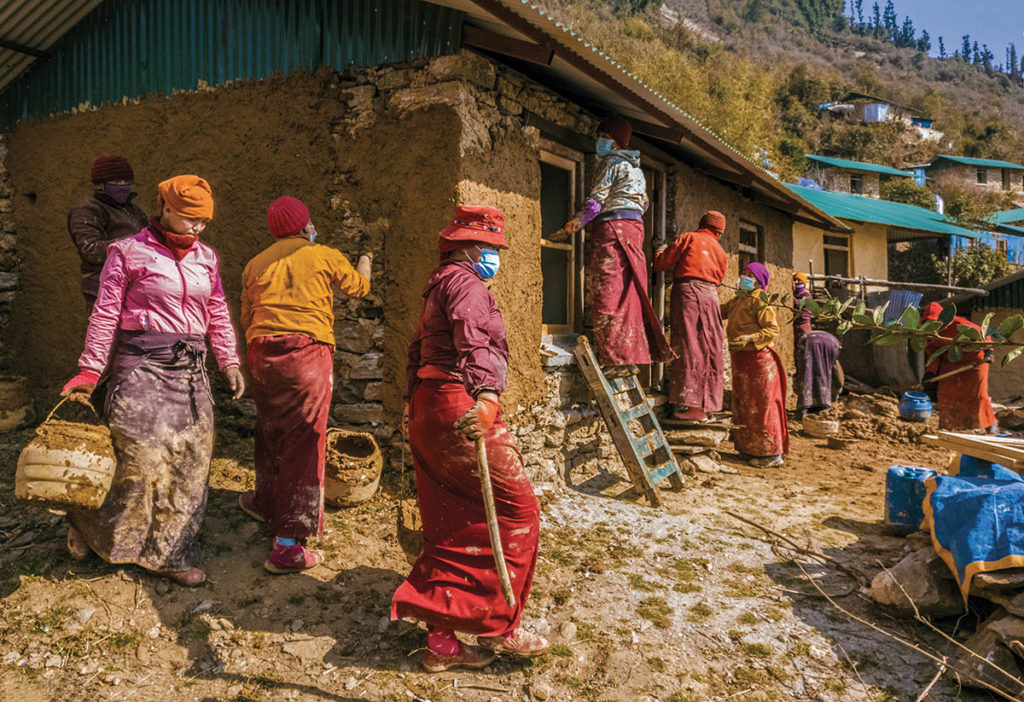Reinforcing a Labour of Love
June 15, 2022
Since Asia has some of the world’s most earthquake-prone countries, it would be remiss if this issue does not shine a light on how lesser known but effective low-cost earthquake-resistant techniques such as containment reinforcement could make an impact, especially in the remote areas of Asia’s hotbed of tectonic activities. This project tells the story of how a Buddhist nunnery in Nepal was rebuilt based on such a technique—applied for the first time in the country—and a highly involved owner approach, coupled with care and love.

It has been said that earthquakes do not kill people; buildings do. In an earthquake, most of the fatalities are caused by the collapse of buildings. Earthquake-induced fatalities and financial losses in many developing countries are largely attributed to damage and destruction of load-bearing masonry buildings constructed with locally available materials such as fired or unfired bricks, stones and mud. Developed nations have worked significantly on safety solutions in construction to reduce earthquake-induced fatalities that are now available, but requiring high-cost technology.
To address this challenge, Hunnarshala Foundation1 developed a cost-effective earthquake-resistant technology called containment reinforcement based on the work of Dr Kaup S. Jagadish, a now-retired professor at the Indian Institute of Science, Bangalore. In this method, each random rubble wall with mud mortar was held together by the introduction of galvanised iron (GI) containment wires, extending from foundation to ceiling, wrapped around the house to prevent flexural failure.
BAKHANG BUDDHIST NUNNERY
This technique was especially useful for Bakhang Buddhist Nunnery where the earthquake in Nepal in 2015 destroyed all 207 meditation homes (it was a shelter to 212 Tibetan refugee nuns), claiming the life of a nun and left several others injured and homeless.



For the nunnery’s reconstruction, the containment reinforcement technique was applied on random rubble masonry structure by using GI containment wires. It was decided that vertical GI containment wires would be provided on two faces of a masonry wall and the reinforcement on the two faces would be connected by ties going through walls to prevent delamination of the walls. The proposed design made minimal changes in the local construction system while using materials that were easier to access and transport to the highly remote location.
RELATED | Containment reinforcement: Other applications
Post-earthquake
The nunnery was situated in Sindhupalchowk, a remote district at the Nepal-China border at 3,000 metres above sea level. The nuns had to stay in a makeshift cramped shelter till relief came. The destruction forced them to move to a temporary resettlement camp in Kathmandu, where the living conditions were substandard. Since most of the nuns were Tibetan refugees, they were excluded from the government’s relief schemes. Financial aid came through the American Jewish World Service’s2 private donations from Tibetan communities in Nepal and elsewhere, as well as USAID. It was coordinated by a non-profit organisation Mountain Resiliency and Sengedag Service Society3 (SSS).


Tanvi Choudhari, an architect from Hunnarshala who was on this project team, explained the collapse, “Most of the houses were built with sandwiched stone walls where stone masonry sandwiches were filled with smaller stones and mud in between. This method was supposed to be a deterrent factor in a seismic event, but due to the lack of through stones and good construction, the walls opened up and collapsed. This process is called delamination.”
Direct involvement of the nuns
The construction process was done closely with the nuns being involved in every step. To save costs, and to resume their spiritual practices quickly, they contributed hard labour. The mud on-site had less clay and thus could not be used as mortar. So, clay had to be excavated from a site downhill, which the nuns did in groups—bringing mud to each house from the excavation site.

They did that often while singing traditional centuries-old construction songs. They carried old stones from destroyed houses, cleaned them, and even provided food to the masons who were working. After the foundation was excavated, the nuns placed ritualised rice grains blessed by their highest spiritual leader the Dalai Lama to impart their faith.
Hunnarshala built the core units of thapsang and chaukhang, and some nuns used their money for beautification and extension of the houses. Some covered the kaushie-verandas with corrugated sheets; some extended their kitchen spaces.
[This is an excerpt. Subscribe to the digital edition or hardcopy to read the complete article.]

Nipun Prabhakar is an independent documentary photographer and architect based in India. He works on long-term projects dealing with intersections of ideas, artifacts, the built environment and folklore. His background as an architect has deeply impacted his sense of space in situations that call for a contextual response to culture and geography. His work has been supported by the Aga Khan Trust for Culture, AKDC at MIT, among others. He is a recipient of the Berkeley Essay Prize 2014 and was Cornell University’s South Asian Fellow 2019-20.
1 Hunnarshala Foundation is an India based non-profit that engages in both community and artisan empowerment. It works with a network of artisans to combine traditional techniques with innovation resulting in buildings, including in post-disaster situations, that are at once eco-friendly, resilient and in keeping with local vernacular.
2 AJWS is a New York-based non-profit development and human rights group.
3 SSS is an organization which manages the nunnery.
4 ‘Earthquake Resistant “Containment Reinforcement” Houses of Stone-Earth without Cement and Steel for Nepal’. COUNTERVIEW.ORG, 24 Nov. 2015, https://counterview.org/2015/11/24/earthquake-resistant-containmentreinforcement-houses-of-stone-earth-without-cement-andsteel-for-nepal/.
5 Abhiyan is a collective of Kachchh-based development organizations with a strong local presence.
RELATED: Commentary | Re-emergence of the Vernacular in India

Read more stories from FuturArc 2Q 2022: New & Re-Emerging Architecture!

To read the complete article, get your hardcopy at our online shop/newsstands/major bookstores; subscribe to FuturArc or download the FuturArc App to read the issues.
Previously Published Commentary
Contact us at https://www.futurarc.com/contact-us for older commentaries.
